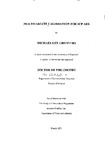MULTIVARIATE CALIBRATION FOR ICP-AES
| dc.contributor.author | GRIFFITHS, MICHAEL LEE | |
| dc.contributor.other | Faculty of Science and Engineering | en_US |
| dc.date.accessioned | 2013-09-24T12:51:43Z | |
| dc.date.available | 2013-09-24T12:51:43Z | |
| dc.date.issued | 2001 | |
| dc.identifier | NOT AVAILABLE | en_US |
| dc.identifier.uri | http://hdl.handle.net/10026.1/1942 | |
| dc.description.abstract |
The analysis of metals is now a major application area for ICP-AES, however, the technique suffers from both spectral and non-spectral interferences. This thesis details the application of univariate and multivariate calibration methods for the prediction of Pt, Pd, and Rh in acid-digested and of Au, Ag and Pd in fusion-digested autocatalyst samples. Of all the univariate calibration methods investigated matrix matching proved the most accurate method with relative root mean square errors (RRMSEs) for Pt, Pd and Rh of 2.4, 3.7, and 2.4 % for a series of synihelic lest solutions, and 12.0, 2.4, and 8.0 % for autocatalyst samples. In comparison, the multivariate calibration method (PLSl) yielded average relative errors for Pt, Pd, and RJi of 5.8, 3.0, and 3.5 % in the test solutions, and 32.0, 7.5, and 75.0 % in the autocatalyst samples. A variable selection procedure has been developed enabling multivariate models to be built using large parts of the atomic emission spectrum. The first stage identified and removed wavelengths whose PLS regression coefficients were equal to zero. The second stage ranked the remaining wavelengths according to their PLS regression coefficient and estimated standard error ratio. The algorithms were applied to the emission spectra for the determination of Pt, Pd and Rh in a synthetic matrix. For independent test samples variable selection gave RRMSEs of 5.3, 2.5 and 1.7 % for Pt, Pd and Rh respectively compared with 8.3, 7.0 and 3.1 % when using integrated atomic emission lines. Variable selection was then applied for the prediction of Au, Ag and Pd in independent test fusion digests. This resulted in RRMSEs of 74.2, 8.8 and 12.2 % for Au, Ag and Pd respectively which were comparable to those obtained using a more traditional univariate calibration approach. A preliminary study has shown that calibration drift can be corrected using Piecewise Direct Standardisation (PDS). The application of PDS to synthetic test samples analysed 10 days apart resulted in RRMSEs of 4.14, 3.03 and 1.88%, compared to 73.04, 44.39 and 28.06 % without correction, for Pt, Pd, and Rh respectively. | en_US |
| dc.description.sponsorship | The Analytical Innovation Programme, Johnson Matthey Ltd. and Department of Trade and Industry | en_US |
| dc.language.iso | en | en_US |
| dc.publisher | University of Plymouth | en_US |
| dc.title | MULTIVARIATE CALIBRATION FOR ICP-AES | en_US |
| dc.type | Thesis | |
| plymouth.version | Full version | en_US |
| dc.identifier.doi | http://dx.doi.org/10.24382/4063 |
Files in this item
This item appears in the following Collection(s)
-
01 Research Theses Main Collection
Research Theses Main


